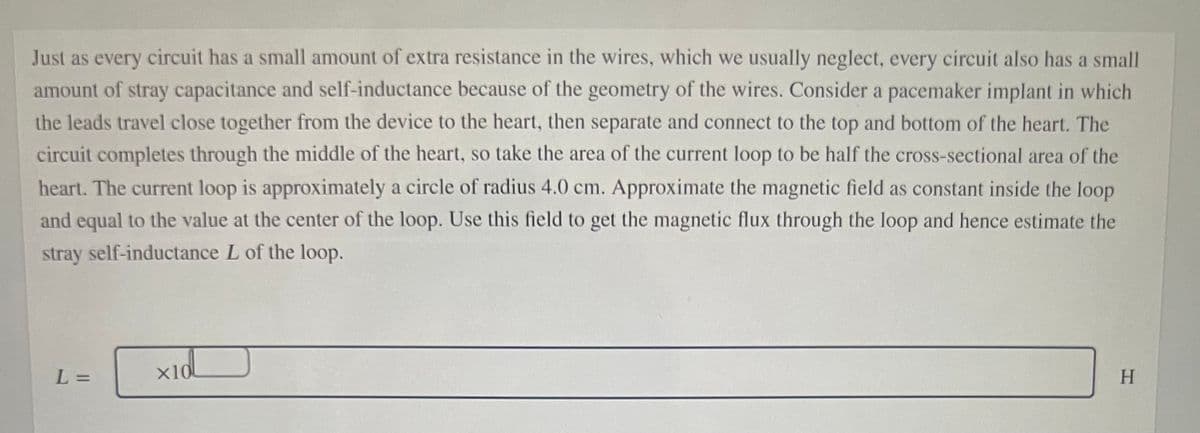Just as every circuit has a small amount of extra resistance in the wires, which we usually neglect, every circuit also has a small amount of stray capacitance and self-inductance because of the geometry of the wires. Consider a pacemaker implant in which the leads travel close together from the device to the heart, then separate and connect to the top and bottom of the heart. The circuit completes through the middle of the heart, so take the area of the current loop to be half the cross-sectional area of the heart. The current loop is approximately a circle of radius 4.0 cm. Approximate the magnetic field as constant inside the loop and equal to the value at the center of the loop. Use this field to get the magnetic flux through the loop and hence estimate the stray self-inductance L of the loop. L = H.
Just as every circuit has a small amount of extra resistance in the wires, which we usually neglect, every circuit also has a small amount of stray capacitance and self-inductance because of the geometry of the wires. Consider a pacemaker implant in which the leads travel close together from the device to the heart, then separate and connect to the top and bottom of the heart. The circuit completes through the middle of the heart, so take the area of the current loop to be half the cross-sectional area of the heart. The current loop is approximately a circle of radius 4.0 cm. Approximate the magnetic field as constant inside the loop and equal to the value at the center of the loop. Use this field to get the magnetic flux through the loop and hence estimate the stray self-inductance L of the loop. L = H.
Chapter14: Inductance
Section: Chapter Questions
Problem 82CP: A coaxial cable has an inner conductor of radius a, and outer thin cylindrical shell of radius b. A...
Related questions
Question

Transcribed Image Text:Just as every circuit has a small amount of extra resistance in the wires, which we usually neglect, every circuit also has a small
amount of stray capacitance and self-inductance because of the geometry of the wires. Consider a pacemaker implant in which
the leads travel close together from the device to the heart, then separate and connect to the top and bottom of the heart. The
circuit completes through the middle of the heart, so take the area of the current loop to be half the cross-sectional area of the
heart. The current loop is approximately a circle of radius 4.0 cm. Approximate the magnetic field as constant inside the loop
and equal to the value at the center of the loop. Use this field to get the magnetic flux through the loop and hence estimate the
stray self-inductance L of the loop.
L% =
x10
H.
Expert Solution
This question has been solved!
Explore an expertly crafted, step-by-step solution for a thorough understanding of key concepts.
This is a popular solution!
Trending now
This is a popular solution!
Step by step
Solved in 2 steps with 2 images

Knowledge Booster
Learn more about
Need a deep-dive on the concept behind this application? Look no further. Learn more about this topic, physics and related others by exploring similar questions and additional content below.Recommended textbooks for you


Glencoe Physics: Principles and Problems, Student…
Physics
ISBN:
9780078807213
Author:
Paul W. Zitzewitz
Publisher:
Glencoe/McGraw-Hill

Physics for Scientists and Engineers: Foundations…
Physics
ISBN:
9781133939146
Author:
Katz, Debora M.
Publisher:
Cengage Learning


Glencoe Physics: Principles and Problems, Student…
Physics
ISBN:
9780078807213
Author:
Paul W. Zitzewitz
Publisher:
Glencoe/McGraw-Hill

Physics for Scientists and Engineers: Foundations…
Physics
ISBN:
9781133939146
Author:
Katz, Debora M.
Publisher:
Cengage Learning

Classical Dynamics of Particles and Systems
Physics
ISBN:
9780534408961
Author:
Stephen T. Thornton, Jerry B. Marion
Publisher:
Cengage Learning

Physics for Scientists and Engineers with Modern …
Physics
ISBN:
9781337553292
Author:
Raymond A. Serway, John W. Jewett
Publisher:
Cengage Learning

Physics for Scientists and Engineers
Physics
ISBN:
9781337553278
Author:
Raymond A. Serway, John W. Jewett
Publisher:
Cengage Learning